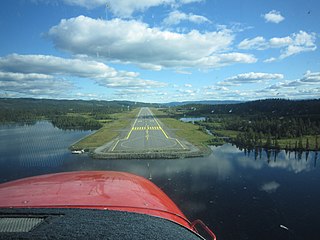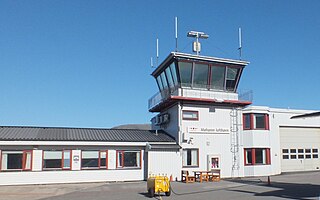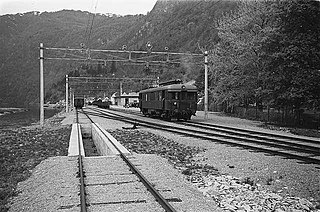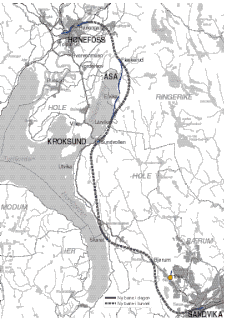Related Research Articles

Transport in Norway is highly influenced by Norway's low population density, narrow shape and long coastline. Norway has old water transport traditions, but road, rail and air transport have increased in importance during the 20th century. Due to the low population density, public transport is somewhat less built out in rural areas of Norway, however public transport in, and around cities is well developed.
Norway elects its legislature on a national level. The parliament, the Storting, has 169 members elected for a four-year term by a form of proportional representation in multi-seat constituencies.

The Bergen Line or the Bergen Railway, is a 371-kilometre (231 mi) long scenic standard gauge railway line between Bergen and Hønefoss, Norway. The name is often applied for the entire route from Bergen via Drammen to Oslo, where the passenger trains go, a distance of 496 kilometres (308 mi). It is the highest mainline railway line in Northern Europe, crossing the Hardangervidda plateau at 1,237 metres (4,058 ft) above sea level.

Fagernes Airport, Leirin is a general aviation airport in Fagernes, in the municipality of Nord-Aurdal, Innlandet county, Norway. It has been a airport for passenger flights, serving Fagernes and the surrounding valleys of Valdres, Hallingdal and Gudbrandsdal in Southern Norway, 190 kilometres (120 mi) from Oslo. Opened in 1987, it was owned and operated by state-owned Avinor. The airport is located 822 metres (2,697 ft) above sea level, and has a 2,049-metre (6,722 ft) runway. It did provide a regional service for the local population to Oslo, subsidized by the Ministry of Transport, as well as charter services during winter serving the nearby ski resorts. In 2014, the airport had 6,393 passengers.

The Nordland Line is a 729-kilometer (453 mi) railway line between Trondheim and Bodø, Norway. It is the longest in Norway and lacks electrification. The route runs through the counties of Trøndelag and Nordland, carrying a combination of commuter, long-haul passenger and freight trains. From Trondheim Central Station to Steinkjer Station the line is most heavily used, with hourly services by the Trøndelag Commuter Rail. There are three branch lines—the Stavne–Leangen Line at Leangen Station, the Meråker Line at Hell Station and the Namsos Line at Grong Station.

Mehamn Airport is a regional airport serving the village of Mehamn in Gamvik Municipality in Finnmark county, Norway. It also serves the villages Kjøllefjord and Gamvik. The airport is located 2 kilometers (1.2 mi) outside of the village of Mehamn and is owned and operated by the state-owned Avinor. The asphalt runway is 880 meters (2,890 ft). Services are operated by Widerøe using Dash 8-100 aircraft which connect to other communities in Finnmark, and the city of Tromsø. The routes are subsidized by the Ministry of Transport and Communications through public service obligations.

The Namsos Line is a 51-kilometer-long (32 mi) railway line between the village of Medjå and the town of Namsos in Trøndelag county, Norway. The line branched off from the Nordland Line at Grong Station and runs through the municipalities of Grong, Overhalla, and Namsos. The line largely follows the river of Namsen. The section from Grong to Skogmo is maintained, although not used for ordinary traffic. The section from Skogmo to Namsos is closed, but the infrastructure remains.
The Åsta accident was a railway accident that occurred at 13:12:25 on 4 January 2000 at Åsta in Åmot, south of Rena in Østerdalen, Norway. A train from Trondheim collided with a local train from Hamar on the Røros Line, resulting in an explosive fire. 19 people were killed, while 67 survived the accident.

Bergen Light Rail is a light rail system in Bergen, Norway. The first stage of the project was a twenty-station stretch between the city center and Lagunen Storsenter, where the first 15 stations comprising a 9.8-kilometre (6.1 mi) stretch opened in 2010, and the second was a 3.6-kilometre (2.2 mi) stretch from Nesttun to Lagunen which opened in June 2013. A third stretch from Lagunen to Bergen Airport, Flesland opened in 2017. Further plans for the project involve mooted extensions to Åsane and Storavatnet.

The Finse Tunnel is a 10,300-metre-long (33,800 ft) railway tunnel west of the village of Finse in Eidfjord Municipality in Vestland county, Norway. The tunnel is part of the Bergen Line between the cities of Oslo and Bergen. It is the longest tunnel on the line, and the third longest railway tunnel in the kingdom. Inside the tunnel, at 1,237 metres (4,058 ft) elevation, is the highest point on the Norwegian railway network.

The Hardanger Line was a 27.45-kilometre (17.06 mi) railway between Voss and Granvin in Hordaland, Norway. The line connected to the Bergen Line in Voss, and ran to the Hardangerfjord and the district of Hardanger. Construction started in 1921, but the line did not open until 1 April 1935. Owned and operated by the Norwegian State Railways (NSB), the passenger transport was provided by three NSB Class 64 electric multiple units. They remained in use until 1985, when passenger transport was terminated. All transport ceased in 1988, and 21 kilometres (13 mi) of the line was demolished in 1991. The 3 kilometres (2 mi) from Voss to Palmafoss remains, and is owned by the Norwegian National Rail Administration. The line featured six stations, fourteen halts, four tunnels and was among Norway's steepest railways. It was NSB's first line to open electrified. The line was known as the Granvin Line until February 1936. In 2016 Palmafoss established an emergency freight terminal and the tracks were reestablished.

The Norwegian Public Roads Administration is a Norwegian government agency responsible for national and county public roads in Norway. This includes planning, construction and operation of the national and county road networks, driver training and licensing, vehicle inspection, and subsidies to car ferries.

The Ålgård Line is a closed, but not abandoned, railway line between Ganddal and Ålgård in Rogaland, Norway. The 12.24-kilometer (7.61 mi) line was built as a narrow gauge branch line of the Jæren Line by the Norwegian State Railways (NSB) and opened in 1924. It runs through the villages of Foss-Eikeland and Figgjo in Sandnes to Ålgård in Gjesdal. Several proposals were made for the Ålgård Line to become the first part of the main line from Stavanger to Oslo, but instead the Sørlandet Line was connected to the Jæren Line in 1944. At the same time, the Ålgård Line was upgraded to standard gauge.
Elisenberg Station is an unfinished railway station within the Oslo Tunnel on the Drammen Line in Oslo, Norway. The ghost station was partially built during the construction of the tunnel between 1971 and 1980, but has never been put into use. It is located between Nationaltheatret Station and Skøyen Station, at Elisenberg in Frogner. A 220-meter (720 ft) long center platform and part of the access way has been built, but never completed. While the station initially was not put into use because of lack of funds to complete it, it is now unlikely that it will ever be completed, as the need for a station has disappeared and an opening would need a large investment of funds.
Oslo Package 3 is a political agreement and plan for investments of 53 billion kr in Oslo and Akershus, Norway. It involves financing for road and public transport infrastructure, as well as operating subsidies to public transport in the period 2008–27. It will be part of the National Transport Plan 2010–19. In addition to state grant, the main financing will be through toll ring around Oslo. The plan is a follow-up on its predecessors, the Oslo Package 1 and Oslo Package 2.

The Ringerike Line is a proposed 40-kilometre (25 mi) extension of the Bergen Line from Hønefoss to Sandvika, Norway. It would reduce travel from Oslo to Bergen by 60 kilometres (37 mi) and 50 minutes. Currently trains from the Bergen Line to Oslo must run via Drammen on the Randsfjord Line and the Drammen Line, or via Roa on the Roa–Hønefoss Line and the Gjøvik Line.

Oslo Package 1 was a political agreement and plan for introducing an urban toll ring around Oslo, Norway, and making 31 investments to road infrastructure in Oslo and Akershus. The package was approved in 1988, and toll charges were introduced in 1990. It was supplemented by Oslo Package 2, which included a similar scheme for public transport. In 2008, they were both replaced by Oslo Package 3.
Norway's elongated shape, its numerous internal geographical barriers, and the often widely dispersed and separated settlements are all factors that have strongly influenced the structure of the country's administrative subdivisions. This structure has varied over time and is subject to continuous review. As of late 2018, plans are nearing completion for a reform of the country's administrative divisions intended to lead, most notably, to the replacement of Norway's current 19 fylker (counties) by 11 new regioner.

The location of the main airport serving the city of Oslo, Norway, has been the subject of several political debates since 1918. The first controversy was initially related to choice between the islands of Gressholmen and Lindøya in the Oslofjord for a water aerodrome. The debate later changed, arriving at the decision in 1933, to locate a new airport at Fornebu. However, Oslo Airport, Fornebu, being located on a peninsula, proved to not have sufficient space for a runway capable of intercontinental aircraft and a second runway, resulting in plans from the 1960s to replace it. The main contestants were Gardermoen Air Station, Hurum, Hobøl, Ås and a split solution between Fornebu and Gardermoen. In 1992, parliament decided to build an all-new Oslo Airport, Gardermoen; when it opened in 1998, Fornebu was closed. The decision caused the southern parts of Eastern Norway to be moved further from the main airport, and the regional, privately owned Sandefjord Airport, Torp became the base for low-cost airlines. Moss Airport, Rygge opened in 2007, becoming the third simultaneous airport to serve Oslo, and closed in 2016.

The Jarlsberg Tunnel is a 1,750-meter (5,740 ft) long double track railway tunnel which runs through Frodeåsen in Tønsberg, Norway. Located on the Vestfold Line, the tunnel was built as part of the 7.8-kilometer (4.8 mi) double-track high-speed segment from Barkåker to Tønsberg. It is located just north of Tønsberg Station and runs between Frodegata and Tomsbakken. Most of the tunnel is blasted, although 223 meters (732 ft) is in a concrete culvert. Planning of the tunnel started in the late 1990s. Several railway interest groups advised against building the isolated segment of upgraded track without a complete plan for upgrading the entire line. Construction started in April 2009 and the new section and the tunnel opened on 7 November 2011. It was the fourth segment of the Vestfold Line to be upgraded.